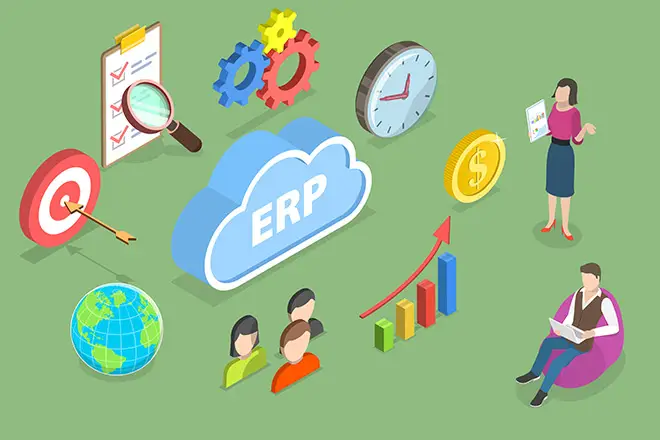Flexibility and a high degree of adaptability - companies that do not meet these requirements often lose out in times of digitalization. As a result, the demands on their IT and, in particular, their ERP systems are also increasing: The use of services from the cloud, mobile application options and the integration of artificial intelligence (AI) are just as much in demand today as the highest security standards and user-friendly interfaces.
Mobile application options for ERP systems and cloud-based approaches are the most important trends in the use of standard business software for more than a third of user companies today - this is a key finding of the Trovarit study "ERP in Practice 2018/2019", for which the analyst firm and its partners surveyed around 2,200 managing directors, IT managers and ERP specialists on the use of their ERP systems. This is not really surprising. After all, flexible ERP systems with a high level of integration capability are a prerequisite for the increasing networking of processes - especially across company boundaries. Instead of rigid suites, companies today are therefore asking for smart ERP services that can be easily combined with each other depending on their requirements. The applications not only have to communicate with each other, but also with mobile devices, external apps or machines. This requires open ERP solutions that can be connected to other systems via the cloud.
In this context, the role of digital platforms is also becoming increasingly important: ERP providers can use them to add functionalities from the cloud to their own solutions (e.g. through services for IoT or AI) or they can offer individual modules as a service themselves. The advantage: the solutions are always up to date and expensive and time-consuming release changes are a thing of the past. In addition, this "division of labor" between basic technology and functionality allows manufacturers to focus more on their core competencies - such as mapping their industry expertise in the solution - which ultimately also benefits users.
Safety has top priority
ERP users also attach great importance to the security of their systems: For 55 percent of study participants, this topic is at the top of the priority list. And rightly so. Because with increasing networking, the attack surface for hackers is becoming ever larger. Many CIOs are therefore still uneasy about obtaining ERP systems or functionalities from the cloud or opening up internal systems to the internet. Providers must therefore ensure that the technologies they use comply with global security standards and are regularly adapted to changing threats.
Hybrid models are the ideal solution for many companies. These offer the flexibility of a cloud solution without companies having to relinquish control over their critical data. One example is the GUS Group's "Digital Hub" - a cloud service that allows user companies to publish selected services and functions of their ERP solution externally via the cloud without giving up sensitive master or transaction data. The solution connects selected data and processes of the ERP system with machines, mobile users, external IT systems or cloud services around the world without a company having to invest in integration solutions. It is therefore no longer necessary to open the company firewall to the outside world in order to exchange data between the ERP system and the digital outside world.
Artificial intelligence as a growth market
A key aspect in connection with ERP systems is the integration and use of artificial intelligence (AI). Based on the study "AI in Europe - Ready for Take-off", the digital association Bitkom estimates that the European market for AI will grow from around three billion euros this year to up to 10 billion euros in 2022. "There is now a wide range of marketable solutions that use artificial intelligence. It ranges from software tools that can be used for voice or image recognition, to ready-made solutions such as chatbots for customer advice, to complex applications that can be used to send personalized mailings with almost no human intervention," says Bitkom CEO Dr Bernhard Rohleder.
Big data as a basis
AI has now also reached the production halls: thanks to predictive maintenance, production systems now "know" about potential problems before they even occur. Sensors continuously collect data and evaluate it in real time. In the event of irregularities, the system immediately sends a warning message to the maintenance department, where the affected spare part is ordered and replaced - before the old one stops working.
The prerequisite for such extensive analyses and forecasts is large amounts of data (big data). ERP systems are now able to store and process structured information and integrate it into existing processes in a meaningful way. Due to digitalization, the type of data is changing: While companies used to have to process mainly structured information, today it is increasingly unstructured data - for example customer feedback from social media channels or sensor data from production. In addition to the cloud, through which companies can flexibly "buy" computing and storage power, technologies such as NoSQL or in-memory databases are helping to make ERP solutions fit for machine learning.
Forms of artificial intelligence and machine learning will also be indispensable for traditional business processes in the future. With the help of structured data from the ERP system, an AI system is continuously trained to automatically recognize correlations and patterns. The ERP data can be analyzed in real time using the model created. The aim is to better predict future events in this way. Finally, AI is also used in the automation of processes, e.g. in accounting: instead of manually assigning invoices, for example, smart applications already make it possible to not only automatically record documents, but also to interpret them and post them correctly. Modern ERP systems should therefore either have corresponding functionalities themselves or be designed in such a way that they can integrate AI and predictive analytics applications and process their results seamlessly.
Focus on usability
Apps and social media, such as Twitter, LinkedIn or Facebook, as well as experience with the simple (mobile) use of software via tablet or smartphone, mean that users also expect sophisticated business software to have a modern, clear interface that makes the applications intuitive and easy to use. According to the Trovarit study, 37 percent of companies therefore consider the software ergonomics of an ERP application to be very relevant. For example, some ERP solutions now offer the option of individually configuring user interfaces. Users can then create their own personal task-based views or configure individual layouts. The user experience in production will also have to adapt to the concepts of modern IoT applications. Voice input or visualizations using augmented reality (AR) and virtual reality (VR) are playing an increasingly important role here. However, communication via chatbots and voice will also be part of the user experience of ERP applications in the future.
Even if digitalization does not turn the ERP world upside down overnight: The upcoming changes are serious. Providers should therefore continuously review their systems and align their development planning with the requirements of the digital future.
from Dirk Bingler


